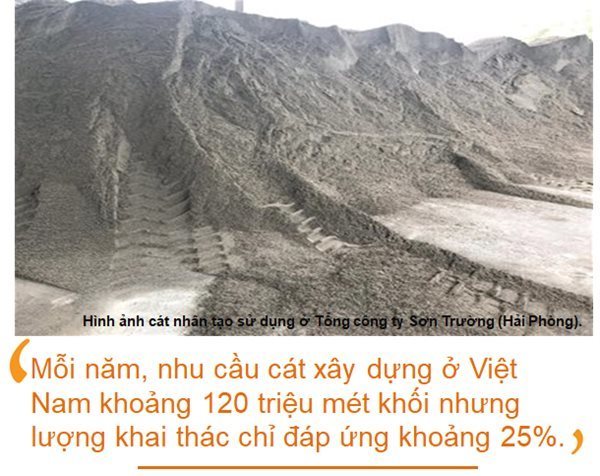Making artificial sand is feasible in Vietnam because of plentiful input materials, while the production process is simple – sorting, washing, removing impurities and grinding to create grains of sand with different sizes for different purposes.

Scientists say that artificial sand grains are more uniform, while it is possible to adjust the proportion of grains. It helps save other building materials such as cement and bitumen, and shortens the execution time and lengthens construction works’ life.
Experiments
In 2012, the Son Truong Corporation in Hai Phong City tried to use fly ash to make centrifugal concrete, but the result was unsatisfactory. The use of unsorted fly ash resulted in products with unstable quality, while the use of selected fly ash the production cost as high as cement.
|
Making artificial sand is feasible in Vietnam because of plentiful input materials, while the production process is simple – sorting, washing, removing impurities and grinding to create grains of sand with different sizes for different purposes. |
In late 2018, Son Truong began using the slag from Hoa Phat Plant’s blast furnace after a successful try. The concrete made of slag is 10 percent cheaper than the concrete made in accordance with traditional methods.
The Minh Duc I Concrete Plant belonging to Son Truong began its operation in early 2005, making retensioned spun high strength concrete and square piles. Every year, when the dry season comes, the Lo River sand supply declines.
In late 2015, the sand shortage became more serious, which pushed the prices up, and the plant began the R&D process to create ground sand. After two months of work, it successfully created a product satisfying the requirements.
The Ministry of Construction (MOC) has encouraged and given guidance on the production and use of artificial sand instead of natural sand for construction works.
The ministry, together with the Ministry of Natural Resources and the Environment (MONRE), is drafting a government decree on river sand management with provisions on encouraging the use of artificial sand instead of natural sand. The required standards on artificial building materials were shown in MOC’s Decision No 430 released in 2017.
Experts have urged the government to reconsider the plan on exploiting and using natural sand to use sand in the most effective way. As for artificial sand, the experts said it is necessary to develop artificial building material plants to satisfy the high volume of materials needed.
Artificial sand is crushed from natural rocks such as limestone, laterite, granite and gravel with modular particles equivalent to natural sand.
The Japanese began using artificial sand 40 years ago to protect resources and to be environmentally friendly. Laos’ construction works are mostly built with sand made from stone.
RELATED NEWS
Sand mining destroying rivers in Central Highlands, causing landslides
Thien Nhien
 Most construction works use illegally exploited sand because legal sources can satisfy only 20 percent of total 120 million cubic meters of sand needed every year." itemprop="description" />
Most construction works use illegally exploited sand because legal sources can satisfy only 20 percent of total 120 million cubic meters of sand needed every year." itemprop="description" />